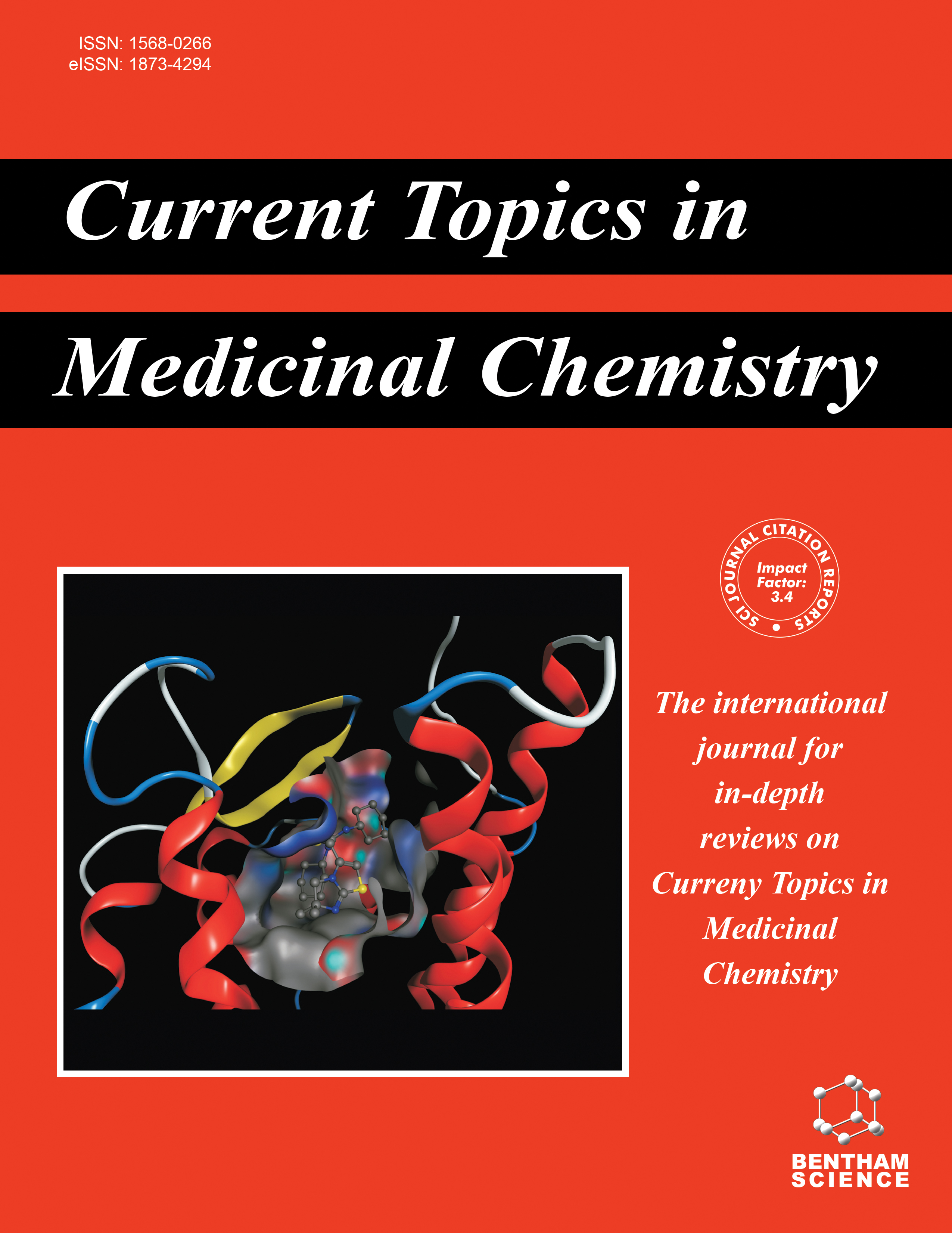- Home
- A-Z Publications
- Current Topics in Medicinal Chemistry
- Previous Issues
- Volume 4, Issue 9, 2004
Current Topics in Medicinal Chemistry - Volume 4, Issue 9, 2004
Volume 4, Issue 9, 2004
-
-
Inhibitors of HIV-1 Gene Expression and Transcription
More LessHuman immunodeficiency virus type 1 (HIV-1) gene expression and transcription is an essential step in the viral life cycle, which is considered to be a possible target for inhibition of HIV-1 replication. Among the factors involved in this step, the cellular transcription factor nuclear factor (NF)-kB is the most potent inducer of HIV-1 gene expression, while the viral transactivator protein Tat seems to play a central role in sustaining a hi Read More
-
-
-
HIV Co-receptors as Targets for Antiviral Therapy
More LessThe chemokine receptors CXCR4 and CCR5 are used as the main co-receptors by the T-cell-tropic (CXCR4-dependent, X4) and macrophage-tropic (CCR5-dependent, R5) HIV-1 strains, respectively, for entering their target cells. The natural ligands for CXCR4, the CXCchemokine SDF-1 and CCR5, the CC-chemokines RANTES, MIP-1a and MIP-1β are described to inhibit viral entry. In this review we focus on chemokine receptor / HIV Read More
-
-
-
Nucleoside Inhibitors of Human Immunodeficiency Virus Type 1 Reverse Transcriptase
More LessThe development of novel compounds that can effectively inhibit both wild type and the most consensus resistant strains of human immunodeficiency virus type 1 (HIV-1) is the primary focus in HIV disease management. Combination therapy, comprising at least three classes of drugs, has become the standard of care for acquired immunodeficiency syndrome (AIDS) or HIV-infected individuals. The drug cocktail c Read More
-
-
-
Current Status of the Non-nucleoside Reverse Transcriptase Inhibitors of Human Immunodeficiency Virus Type 1
More LessBy J. BalzariniAlmost fifteen years ago, the first non-nucleoside reverse transcriptase (RT) inhibitor (NNRTI) lead compounds have been discovered. Nowadays, three NNRTIs are approved for treatment of HIV-1-infected individuals and several others are subject of (advanced) clinical trials. Although the NNRTIs target HIV-1 RT, they are clearly different from the nucleoside RT inhibitors (NRTIs). They are highly selective for HIV-1 and do no Read More
-
-
-
TSAO Compounds: The Comprehensive Story of a Unique Family of HIV- 1 Specific Inhibitors of Reverse Transcriptase
More LessEmergence of drug-resistant viral strains is one of the major milestones and the main cause for the failure of antiretroviral therapy. Combination of different anti-HIV agents has become the standard clinical practice to keep the viral load at low or even undetectable levels and to prevent emergence of virus-drug resistance. Among the human immunodeficiency virus (HIV) reverse transcriptase (RT) inhibitors, the so called Read More
-
-
-
Structure and Function of HIV-1 Integrase
More LessAuthors: Thang K. Chiu and David R. DaviesHIV-1 integrase is a multidomain enzyme which is required for the integration of viral DNA into the host genome. It is one of three enzymes of HIV, the others being the Reverse Transcriptase and the Protease. It is an attractive target for therapeutic drug design. The enzyme consists of three domains. The N-terminal domain has a His2Cys2 motif which chelates zinc, the core domain has the catalytic DDE motif which is require Read More
-
-
-
HIV-1 Integrase: A Target for New AIDS Chemotherapeutics
More LessSince the beginning of the HIV epidemic almost 70 million people have been infected with HIV. It is estimated that 42 million people are currently living with HIV/AIDS. The spread of HIV continues throughout the world and current estimates indicate that in 2002, 5 million people were newly infected with HIV and 3 million people died. Current treatments employ a combination of therapeutic agents that target the viral reverse Read More
-
-
-
HIV Protease Inhibition: Limited Recent Progress and Advances in Understanding Current Pitfalls
More LessAuthors: Fatima Rodriguez-Barrios and Federico GagoThe identification of HIV-1 protease (HIVp) as a target for therapeutic intervention against AIDS was soon followed by major efforts to understand its substrate specificity, reaction kinetics and three-dimensional structure, both in the free state and in complex with a number of ligands including substrate mimics, products, and inhibitors. On the whole these studies have been extremely successful and have had a major impact on Read More
-
-
-
Antiviral Profile of HIV Inhibitors in Macrophages: Implications for Therapy
More LessAuthors: C.- F. Perno, E. Balestra, M. Francesconi, D. Abdelahad, R. Calio, J. Balzarini and S. AquaroMacrophages (M / M) are identified as the second cellular target of HIV and a crucial virus reservoir. M / M are persistently infected cells and not susceptible to the HIV cytophatic effects typical of infected CD4+ T-lymphocytes. HIV replication in M / M is a crucial pathogenetic event during the whole course of the disease. Moreover, the dynamics of HIV-1 replication and cumulative virus production is quite different in M / M and Read More
-
Volumes & issues
-
Volume 25 (2025)
-
Volume 24 (2024)
-
Volume 23 (2023)
-
Volume 22 (2022)
-
Volume 21 (2021)
-
Volume 20 (2020)
-
Volume 19 (2019)
-
Volume 18 (2018)
-
Volume 17 (2017)
-
Volume 16 (2016)
-
Volume 15 (2015)
-
Volume 14 (2014)
-
Volume 13 (2013)
-
Volume 12 (2012)
-
Volume 11 (2011)
-
Volume 10 (2010)
-
Volume 9 (2009)
-
Volume 8 (2008)
-
Volume 7 (2007)
-
Volume 6 (2006)
-
Volume 5 (2005)
-
Volume 4 (2004)
-
Volume 3 (2003)
-
Volume 2 (2002)
-
Volume 1 (2001)
Most Read This Month
Article
content/journals/ctmc
Journal
10
5
false
en


